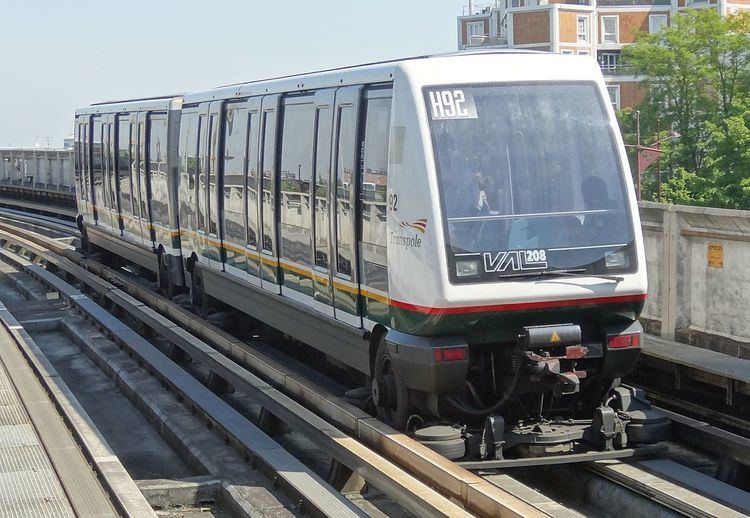 | ||
VAL is a type of automatic rubber-tyred people mover technology, based on an invention by Professor Robert Gabillard from the Université Lille Nord de France. It was designed in the early 1980s by Matra and first used for the then-new metro system in Lille. This was one of the world's first fully automated driverless mass-transit rail networks to serve a city centre (preceded only by the Port Island Line in Kobe, Japan), and the first such in Europe.
Contents
- Technology
- List of VAL systems
- Other uses of VAL technology
- NeoVal
- CityVal
- Medium Capacity System
- References
The acronym was originally for Villeneuve d'Ascq à Lille (Villeneuve d'Ascq to Lille), the route of the first line to be projected (and inaugurated). It now officially stands for Véhicule Automatique Léger (automatic light vehicle).
In contrast to some other driverless metro systems like the Docklands Light Railway or Vancouver's SkyTrain, the VAL design uses platforms that are separated from the rollways by a glass partition, to prevent waiting passengers from straying or falling onto the rollways. Platform screen doors–produced by Swiss glass door manufacturer Kaba Gilgen AG–are embedded in these partitions and open in synchrony with the train doors when a train stops at the platform. The original platform-edge doors were manufactured and installed by PLC Peters in Hayes, Middlesex and were used on the first line.
In addition to the trains being driverless, the station platforms are unstaffed in normal operation. In the original Lille metro system, they are monitored by a large closed-circuit television system with 330 cameras and 24 television monitors in a remote control room.
Technology
The VAL system uses a fully automated elevated guideway, which may be metal or concrete depending on prevailing weather conditions. Primary suspension is by rubber tires, with pairs of horizontal tires to provide lateral guidance. Electrical power at 750v DC is collected by shoes from the guidebars.
The vehicles are lightweight 2-car sets (VAL 206) with 124 total capacity, or twin sets (VAL 256) with 80 seated and 160 standing capacity. All axles on these vehicles are motored with 150 kW electrical motors. The system detects the location of trains on the guideway by the use of ultrasonic sensors.
VAL can cope with unanticipated demand by inserting additional trains into the network as required by remote command from the control center. The control center computer system automatically speeds up or slows down trains in order to maintain a timetable. The VAL system can handle headways as small as 60 seconds, and the Lille VAL system rapidly proved itself with a 99.8% availability.
List of VAL systems
Outside France, VAL systems are also used in:
The Chicago O'Hare and Taipei lines use the wider VAL 256 version of the system.
Jacksonville, Florida had a VAL line inaugurated in 1989; this was shut down in December 1996 and replaced by a monorail, the Jacksonville Skyway. The rolling stock was sold to O'Hare.
Other uses of VAL technology
NeoVal
In 2006 the NeoVal project, successor of the VAL, was announced. It will feature regenerative braking. 40% of the 62 million Euros set aside for the programme will come from Oseo (the technology-supporting project agency formerly known as the AII). The program is managed by Siemens, in association with Lohr Industrie. The NeoVal will be guided by a single central rail, similar to that of the Translohr, and will be able to operate without any electrical supply between the stations (no third rail or overhead), making the cost of infrastructure much lower.
CityVal
CityVal is based on the NeoVal system. 19 CityVal trainsets have been ordered for the second line of the Rennes Metro.
Medium Capacity System
When VAL was introduced to Taipei, the term medium-capacity rail transport system was coined by railway planners to differentiate VAL from heavy rail (metro). Since then, this term has begun to be applied on similar capacity transit systems–mainly in Asian cities–even when the systems are not based on VAL's technology. On Siemens' official website, VAL is advertised as the "first fully automated light metro", in which the term "light metro" can be traced back to Moscow Metro Butovskaya Light Metro Line.
